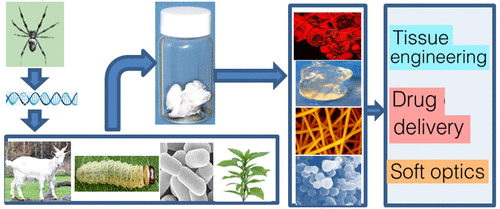当前位置:
X-MOL 学术
›
ACS Biomater. Sci. Eng.
›
论文详情
Our official English website, www.x-mol.net, welcomes your
feedback! (Note: you will need to create a separate account there.)
Recombinant Spidroins as the Basis for New Materials
ACS Biomaterials Science & Engineering ( IF 5.4 ) Pub Date : 2020-06-09 , DOI: 10.1021/acsbiomaterials.0c00109 Vladimir G. Debabov 1 , Vladimir G. Bogush 1
ACS Biomaterials Science & Engineering ( IF 5.4 ) Pub Date : 2020-06-09 , DOI: 10.1021/acsbiomaterials.0c00109 Vladimir G. Debabov 1 , Vladimir G. Bogush 1
Affiliation

|
Spider web proteins are unique materials created by nature that, considering the combination of their properties, do not have analogues among natural or human-created materials. Obtaining significant amounts of these proteins from natural sources is not feasible. Biotechnological manufacturing in heterological systems is complicated by the very high molecular weight of spidroins and their specific amino acid composition. Obtaining recombinant analogues of spidroins in heterological systems, mainly in bacteria and yeast, has become a compromise solution. Because they can self-assemble, these proteins can form various materials, such as fibers, films, 3D-foams, hydrogels, tubes, and microcapsules. The effectiveness of spidroin hydrogels in deep wound healing, as 3D scaffolds for bone tissue regeneration and as oriented fibers for axon growth and nerve tissue regeneration, was demonstrated in animal models. The possibility to use spidroin micro- and nanoparticles for drug delivery was demonstrated, including the use of modified spidroins for virus-free DNA delivery into animal cell nuclei. In the past few years, significant interest has arisen concerning the use of these materials as biocompatible and biodegradable soft optics to construct photonic crystal super lenses and fiber optics and as soft electronics to use in triboelectric nanogenerators. This review summarizes the latest achievements in the field of spidroin production, the creation of materials based on them, the study of these materials as a scaffold for the growth, proliferation, and differentiation of various types of cells, and the prospects for using these materials for medical applications (e.g., tissue engineering, drug delivery, coating medical devices), soft optics, and electronics. Accumulated data suggest the use of recombinant spidroins in medical practice in the near future.
中文翻译:

重组螺蛋白作为新材料的基础
蜘蛛网蛋白是自然界创造的独特材料,考虑到其性质的结合,在自然或人类创造的材料中没有类似物。从天然来源获得大量的这些蛋白质是不可行的。蜘蛛蛋白的分子量非常高及其特定的氨基酸组成,使异源系统中的生物技术制造变得复杂。在杂种学系统中,主要是在细菌和酵母中,获得spidroins的重组类似物已成为一种折衷的解决方案。由于它们可以自我组装,因此它们可以形成各种材料,例如纤维,薄膜,3D泡沫,水凝胶,管和微胶囊。Spidroin水凝胶在深层伤口愈合中的功效,在动物模型中已证明,其可用于骨骼组织再生的3D支架以及用于轴突生长和神经组织再生的定向纤维。证明了使用spidroin微粒和纳米颗粒进行药物递送的可能性,包括使用修饰的spidroin将无病毒的DNA递送至动物细胞核。在过去的几年中,关于将这些材料用作生物相容性和可生物降解的软光学器件以构造光子晶体超透镜和光纤以及用作摩擦电纳米发电机中使用的软电子器件,引起了极大的兴趣。这篇综述总结了在spidroin生产领域的最新成就,基于它们的材料的创建以及对这些材料作为各种细胞的生长,增殖和分化的支架的研究,以及将这些材料用于医疗应用(例如组织工程,药物输送,涂层医疗设备),软光学和电子学的前景。积累的数据表明在不久的将来在医学实践中将使用重组spidroins。
更新日期:2020-07-13
中文翻译:

重组螺蛋白作为新材料的基础
蜘蛛网蛋白是自然界创造的独特材料,考虑到其性质的结合,在自然或人类创造的材料中没有类似物。从天然来源获得大量的这些蛋白质是不可行的。蜘蛛蛋白的分子量非常高及其特定的氨基酸组成,使异源系统中的生物技术制造变得复杂。在杂种学系统中,主要是在细菌和酵母中,获得spidroins的重组类似物已成为一种折衷的解决方案。由于它们可以自我组装,因此它们可以形成各种材料,例如纤维,薄膜,3D泡沫,水凝胶,管和微胶囊。Spidroin水凝胶在深层伤口愈合中的功效,在动物模型中已证明,其可用于骨骼组织再生的3D支架以及用于轴突生长和神经组织再生的定向纤维。证明了使用spidroin微粒和纳米颗粒进行药物递送的可能性,包括使用修饰的spidroin将无病毒的DNA递送至动物细胞核。在过去的几年中,关于将这些材料用作生物相容性和可生物降解的软光学器件以构造光子晶体超透镜和光纤以及用作摩擦电纳米发电机中使用的软电子器件,引起了极大的兴趣。这篇综述总结了在spidroin生产领域的最新成就,基于它们的材料的创建以及对这些材料作为各种细胞的生长,增殖和分化的支架的研究,以及将这些材料用于医疗应用(例如组织工程,药物输送,涂层医疗设备),软光学和电子学的前景。积累的数据表明在不久的将来在医学实践中将使用重组spidroins。











































 京公网安备 11010802027423号
京公网安备 11010802027423号